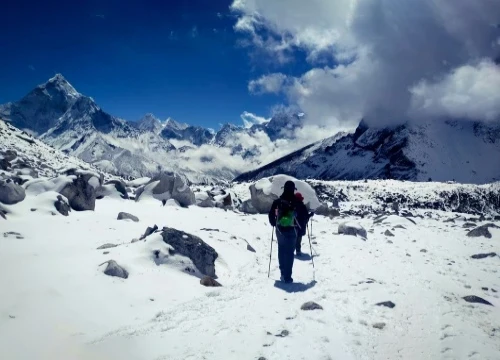Have you ever wondered how many times the location of Everest Base Camp has changed throughout history? In this article, we will unveil the fascinating history behind the shifting base camp of the world's tallest mountain. From the early expeditions of Sir Edmund Hillary and Tenzing Norgay in the 1950s to the present day, Everest Base Camp has seen several relocations due to various factors. Through in-depth research and analysis, we will explore the reasons behind these changes, such as the impact of avalanches, climate change, and the need for better facilities for climbers. Join us on this journey as we delve into the rich history of Everest Base Camp, discovering how it has evolved over time and the significance of each relocation. Whether you're an adventure enthusiast, a history buff, or simply curious about the famous mountain, this article will provide you with a comprehensive understanding of the ever-changing home of the brave climbers who conquer Mount Everest.
How many times has Everest Base Camp's location changed?
Table of Contents
The early days of Everest Base Camp
Everest Base Camp, the starting point for climbers attempting to conquer Mount Everest, has a long and storied history. In the early days, before the mountain became a popular destination for adventurers, the concept of a base camp did not exist. Expeditions were often small and self-sufficient, with climbers setting up temporary camps wherever they could find suitable spots. It wasn't until the 1950s, when Sir Edmund Hillary and Tenzing Norgay successfully reached the summit, that the idea of a permanent base camp started to take shape.
The first recorded location changes of Everest Base Camp occurred during the British Mount Everest Expedition in 1921. The expedition, led by George Mallory, set up their base camp in the East Rongbuk Glacier. However, due to difficult terrain and limited resources, they were forced to relocate to a new site known as North Base Camp. This change set a precedent for future expeditions and marked the beginning of the shifting base camp of Everest.
The early base camps were basic and lacked the infrastructure and facilities that climbers enjoy today. They consisted of simple tents and temporary structures, providing only the bare essentials for the climbers. However, as mountaineering became more popular and the number of expeditions increased, the need for better facilities and support services became apparent.
The first recorded location change
The history of Everest Base Camp dates back to the early 20th century when the first recorded location change took place. In 1921, the British Mount Everest Reconnaissance Expedition, led by George Mallory, established the first base camp on the southern side of Everest. This initial location was chosen based on the team's limited knowledge of the mountain and the surrounding terrain. However, due to the lack of proper infrastructure and resources, the base camp was later moved to a new location in 1922 AD.
The second base camp, situated at a higher elevation, provided better access to the mountain and improved living conditions for the climbers. This relocation marked the beginning of a pattern that would continue in the following years as expeditions sought to find the optimal location for their ascent.
In the years that followed, several expeditions attempted to conquer Everest, each establishing their own base camp at different locations. The precise details of these early base camps are often difficult to ascertain due to the limited documentation available. Nevertheless, it is clear that the location of Everest Base Camp underwent significant changes during this period, as mountaineers explored different routes and approaches to the summit.
Major location changes in the 20th century
The 1950s marked a turning point in the history of Everest Base Camp, with the successful expeditions of Sir Edmund Hillary and Tenzing Norgay. In 1953, they became the first climbers to reach the summit of Everest, using a route from the southern side of the mountain. This achievement brought international attention to Everest and led to the establishment of a more permanent base camp.
The location chosen for this new base camp, known as South Base Camp, was at an elevation of approximately 5,364 meters (17,598 feet). It provided a central location for climbers attempting to summit Everest from the southern side, and it became the starting point for most expeditions in the decades that followed.
However, as the number of climbers attempting to conquer Everest increased over the years, the South Base Camp faced challenges in accommodating the growing demand. The limited space and resources led to overcrowding, making it necessary to explore alternative locations for base camps.
In the late 20th century, several major location changes occurred to address these concerns. In 1978, a new base camp, known as North Base Camp, was established on the northern side of Everest. This location, situated in Tibet at an elevation of approximately 5,150 meters (16,896 feet), provided an alternative route for climbers and helped alleviate the overcrowding at the South Base Camp.
Reasons for location changes
The shifting location of Everest Base Camp can be attributed to various factors. One of the primary reasons for these changes is the impact of avalanches. The unpredictable nature of avalanches poses a significant risk to climbers and the infrastructure at the base camp. As a result, relocating the base camp to safer locations has become necessary to minimize the danger posed by these natural disasters.
Another factor influencing the location changes is climate change. The melting of glaciers and the changing patterns of snowfall have affected the stability of the terrain surrounding Everest. These environmental changes have made certain routes more treacherous and have necessitated the exploration of alternative paths to the summit. As a result, base camps have been relocated to adapt to these changing conditions and ensure the safety of climbers.
Furthermore, the need for better facilities and infrastructure has also led to location changes. As the popularity of climbing Mount Everest has grown, the demand for proper accommodation, communication systems, and medical facilities has increased. Relocating the base camp allows for the construction of improved facilities that cater to the needs of climbers, making their journey safer and more comfortable.
Impact of location changes on climbers and expeditions
The location changes at Everest Base Camp have had a significant impact on climbers and expeditions. Each relocation brings its own set of challenges and advantages, influencing the overall experience of climbers attempting to conquer Everest.
The availability of better facilities and resources at the base camp can greatly enhance the chances of a successful summit. Improved medical facilities and communication systems allow for quicker response times in case of emergencies, increasing the safety of climbers. Additionally, a well-established base camp provides a more comfortable environment for acclimatization and recovery, enabling climbers to perform at their best during the ascent.
However, location changes also present challenges. Climbers must adapt to new routes and conditions, requiring additional time and effort to familiarize themselves with the terrain. These changes may affect the logistics of the expedition, including the availability of essential supplies and support services. Climbers and expedition organizers must carefully plan and adjust their strategies to account for the new base camp location, ensuring a smooth and successful ascent.
Controversies surrounding location changes
The relocation of Everest Base Camp has not been without controversy. Some argue that the frequent changes disrupt the natural ecosystem and cultural heritage of the region. Each relocation requires the construction of new infrastructure, which can have unintended consequences for the fragile mountain environment. Additionally, the influx of climbers and the development of facilities can disrupt the traditional way of life for the local Sherpa communities.
Another point of contention is the commercialization of Everest. The growing popularity of climbing the mountain has led to an increase in commercial expeditions, resulting in overcrowding and excessive waste at the base camps. Critics argue that the focus on profit and the desire for personal achievement have overshadowed the environmental and cultural concerns associated with climbing Everest.
To address these controversies, there have been calls for stricter regulations and responsible tourism practices. Efforts are being made to ensure sustainable management of Everest Base Camp and to minimize the negative impact on the environment and local communities. Balancing the interests of climbers and expedition organizers and the preservation of the natural and cultural heritage of the region remains an ongoing challenge.
Future prospects and potential location changes
As the popularity of climbing Mount Everest continues to grow, future location changes are likely to occur. The impact of climate change, the need for improved infrastructure, and the desire to manage the increasing number of climbers will all influence the decision-making process.
In the face of climate change, the stability of the mountain and the surrounding terrain may undergo further changes. This could require the exploration of new routes and the establishment of base camps at different locations. Additionally, advancements in technology and infrastructure may offer opportunities for the development of more sustainable and environmentally friendly base camps.
The future of Everest Base Camp also depends on the collective efforts of climbers, expedition organizers, governments, and local communities. Responsible tourism practices, conservation initiatives, and sustainable development strategies will play a crucial role in ensuring the long-term viability of Everest Base Camp as a base for climbers and a symbol of human achievements.
Conclusion
The history of Everest Base Camp is a testament to the enduring spirit of exploration and the pursuit of human achievement. From its humble beginnings to its current state as a hub of mountaineering, the base camp has evolved and adapted to the challenges posed by nature and the growing interest in climbing Mount Everest.
Through numerous location changes, Everest Base Camp has seen the triumphs and tragedies of countless climbers. Each relocation has brought with it new opportunities and challenges, shaping the experience of those who dare to conquer the world's tallest mountain.
As we look to the future, it is essential to recognize the delicate balance between our desire to conquer nature and our responsibility to protect it. The shifting base camp of Everest serves as a reminder of the need for sustainable practices, environmental stewardship, and cultural preservation.
Whether you dream of climbing Everest or simply appreciate the indomitable spirit of human exploration, the history of Everest Base Camp offers a glimpse into the remarkable journey of those who have ventured to the top of the world. As we unveil the stories behind each relocation, may we continue to be inspired by the triumphs and challenges that define the ever-changing home to the brave climbers who conquer Mount Everest.





